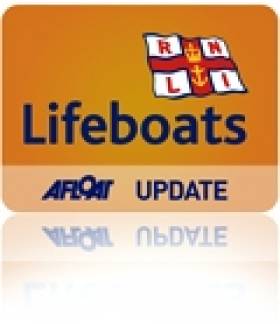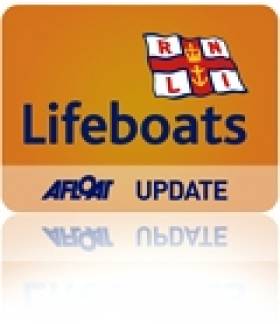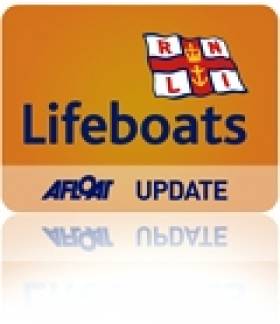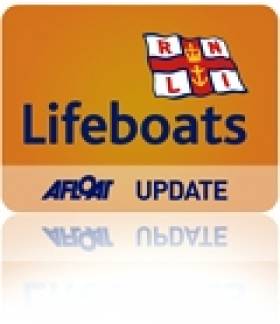Displaying items by tag: Lifeboats
Lough Ree Locals Praise New RNLI Lifeboat Station
#Lifeboats - RTÉ News has a video report on a memorial to lives lost on the Shannon recently installed at the location of Lough Ree's new lifeboat station.
Relatives of those lost to the waterway spoke of their appreciation for the setting up of the new search and rescue base for the mid-Shannon after a decade of campaigning.
As reported on Afloat.ie last July, the RNLI's 44th lifeboat station in Ireland - located at Coosan Point in Athlone - Co Westmeath, has been welcomed as a search and rescue asset on Lough Ree and the Shannon.
Some €150,000 has been invested in the temporary facilities, from which volunteers operate the B class Atlantic 75 lifeboat Dorothy Mary, on a year-long trial basis.
According to RNLI Lough Ree's Matt Harte, the new station was among the busiest in Ireland last year, with up to 20 call-outs in its six months of operation thus far.
Sligo Sea Shanty Festival Returns For Fourth Year
#MaritimeFestivals - Running for the last three years, Sligo Bay RNLI is once again preparing for the Sea Shanty Festival in Rosses Point later this summer, with all proceeds going to the lifeboat station.
"The festival is a celebration of the long maritime tradition of Rosses Point and the Sligo area," as festival committee chair Willie Murphy explained last year.
"Shanties were working songs used on board sailing ships. The songs were mostly sung when the job involved several crew members working in rhythm together."
One of the many groups that have performed in the past is The Drunken Sailors from Germany, who have written a song inviting people back to Sligo Bay for the 2013 festival from 14-16 June.
The group’s story goes that back in the summer of 2012, the Drunken Sailor Shantymen were infected by the ‘Sligo Bay Virus’, and they asked their witch-doctor what medicine would help.
"You were infected by a well-known serious music virus out of the north-west of Ireland," they were told. "And the only think what may help, is to sing a song which tells a story of Sligo Bay.
"But take the medicine without any alcohol or other drugs, sing a great song for all friends of shanty music and you will get better!"
With this advice, the brave Drunken Sailor Shantymen started to sing the song you can hear in the video above, and which they think may move all famous artists to come back to Rosses Point Sea Shanty Festival later this year.
161 Lives Saved by Irish Coast Guard in 2012
#Coastguard - The Irish Times reports that the Irish Coast Guard saved 161 lives since January this year.
It was also the busiest year on record or the coastguard search and rescue service, with 1,963 call-outs in the past 12 months, an 8% increase on the previous year.
Minister for Transport Leo Varakdar was due in Howth this afternoon to pay tribute to staff and volunteers with both the Irish Coast Guard and RNLI lifeboats for their invaluable work.
“Without these volunteers, it simply wouldn’t be possible to provide the same level of emergency response," he commented.
In more sobering statistics, 88 bodies were recovered from the water in 2012, which is the highest annual number ever recorded.
And hoax calls were also on the up, with an "unacceptably high" 325 of such calls logged since January.
The Irish Times has more on the story HERE.
Howth Trawler Assist Features on 'Ireland's Search and Rescue'
#Rescue - The most recent episode of Ireland's Search and Rescue features a combined mission by Howth RNLI and the Irish Coast Guard to aid a fishing vessel off Howth earlier this year.
As previously reported on Afloat.ie, the Howth lifeboat crew spent more than 10 hours on 4 February last assisting the 17-metre trawler, with seven crew on board, which was rapidly taking on water.
The coastguard rescue helicopter was also on scene to help the stricken vessel, winching a salvage pump on board to try to stem the water flow amid difficult weather and sea conditions.
The programme is available online via RTÉ Player until 31 December.
The six-part series on RTÉ One has previously featured exclusive footage of the Tit Bonhomme rescue effort at Glandore Harbour in West Cork last January.
Sole survivor of the tragedy, Abdul Mohammed, spoke to presenter Claire Byrne about his struggle to survive the ordeal that claimed the life of his brother Wael and the four other crew.
ESB Retiree Donates Gift Money to Bundoran RNLI
#RNLI - After 43 years working with the ESB, a Co Donegal man has donated €700 – money in lieu of retirement presents – to Bundoran RNLI.
Ballyshannon’s Brendan 'Mannix' Gallagher held his retirement party last Friday 30 November at the Allingham Arms in Bundoran but opted not for presents for himself but donations to Bundoran RNLI.
A crowd of well over 200 people attended the festivities on the night and all were delighted to make a donation to the local volunteer lifeboat service.
Brendan is well known in the area for his fundraising so it came as no surprise to the party goers that he requested donations to the RNLI.
Tony McGowan, Bundoran RNLI lifeboat operations manager, said: "We are very grateful to Brendan and his wife Joan for this thoughtful and generous method of donating to the lifeboat.
"The gesture has raised over €700 for Bundoran RNLI and will go towards the training of our volunteer crew to continue to save lives at sea."
Brendan’s retirement party is not the only local fundraiser for Bundoran RNLI at the moment. Shoppers at Sweeny Todds in Market Square Shopping Centre can purchase their Christmas cards there, and with every sale from the selected range a 50 cent donation will be made to Bundoran RNLI.
Next Sunday 16 December, the Pier Head Hotel in Mullaghmore will hold a charity wax in aid of Bundoran RNLI as part of their Christmas Family Fun Day. And the annual Bundoran Lifeboat Dinner Dance will take place at the Great Northern Hotel on Friday 1 February 2013. Tickets are on sale now from all crew members.
Bundoran RNLI also reminds the public that these are the only fundraisers at present, after reports of a 'bogus Santa' charity collector seen in Bundoran last month.
TV3 Christmas Special to Feature 'Unsung Heroes' of Arklow RNLI
#RNLI - Volunteers from Arklow RNLI in Co Wicklow are to feature in a Christmas special to be broadcast on TV3.
The documentary, Unsung Heroes, will highlight the efforts of those who provide the essential rescue service throughout the year, including over the festive season.
It will be broadcast twice over Christmas, first at 8pm on Friday 21 December and again at 8pm on Sunday 23 December.
A TV3 film crew spent the morning of Tuesday 27 November at Arklow RNLI filming at what is the oldest of the 44 lifeboat stations in Ireland.
Producer Patrick Kinsella and cameraman Vinnie Broderick shadowed the volunteers on a training-based exercise when they launched their all-weather Trent class lifeboat, the Ger Tiighcelarr.
"The documentary is about unsung heroes," said Kinsella, "and I suppose given my own experience having worked in the shipping industry, I feel the RNLI and its people – the men and women who run and manage this organisation - cannot be praised enough for putting their lives at risk to save others, and I think this programme is a good way to shine a light on the work they do."
During the exercise, Kinsella and Broderick had the opportunity to experience first-hand and get a glimpse of the level of training required by RNLI volunteers to become highly skilled and efficient in order to carry out lifesaving work which can often be difficult and sometimes dangerous.
Interviews were carried out with lifeboat operations manager Jimmy Tyrell, coxswain Ned Dillon and volunteer crew member Stephen Furlong. Tyrell said filming with TV3 was a great opportunity to showcase the commitment of volunteers, not only in Arklow but in the many other coastal and inland water communities across Ireland.
He said the RNLI wouldn’t exist without fundraising, adding that the charity was totally reliant on the generosity of the public and indebted to work of fundraisers at station branches as well as those raising money inland.
Tyrell also said crew members would happily exchange their Christmas dinner and the comfort of their homes should the need arise this year to help anyone who may find themselves in difficulty at sea.
"It is because of the willingness and selfless nature of our volunteers, who will readily swap leisure, comfort and sleep for cold, wet and fatigue that the charity can provide an on-call, 24-hour lifeboat search and rescue service here," he said. "The RNLI depends on its volunteers who give their time, skill and commitment, even at Christmas time.
"Indeed, while our lifeboats are busy all year round, some of the most challenging callouts can occur over the winter months. And while most of us will be enjoying the Christmas festivities with our loved ones, we know that somewhere, RNLI lifeboats will be launched to help save lives at sea."
Donaghdee RNLI Comes To Aid of Drifting Fishing Boat
#RNLI - Donaghadee RNLI has assisted two people whose boat got into difficulty off Co Down.
The station’s volunteer lifeboat crew was out on a training exercise on Sunday morning when they were requested to go to the aid of a 30-ft fishing vessel off the Copeland Islands.
Two people were on board the vessel which was drifting off South Briggs. Within minutes the lifeboat was on the scene and found the vessel had a rope around its propeller.
The lifeboat crew was able to establish a tow rope across to the vessel and towed it safely into Groomsport Harbour.
Lough Swilly RNLI Rescues Crew From Stricken Fishing Boat
#RNLI - Lough Swilly RNLI rescued five people onboard a 50ft fishing boat yesterday evening (Sunday 2 December) after the vessel’s engine broke down in Co Donegal.
During what was a nine-hour callout in tough weather conditions, Portrush RNLI also launched to assist the stricken Mary Ellen.
Volunteer crew members from Lough Swilly had been attending a commemoration in Portsalon when they were requested to launch to the boat that had broken down some 10 miles further on, a mile-and-a -half from Fannad Lighthouse.
The all-weather Tyne class lifeboat arrived on scene at 3.15pm where the crew observed a steel crabber with five men onboard. The fishing boat was carrying a load of crab.
Weather conditions at the time were described as blowing gusts of between gale force 5 and 6 up the lough.
The crew pursued to establish a towline and commence the return journey to shore. After towing the vessel for a couple of hours into the dark, the tide began to turn, making the pull more difficult. A relief lifeboat from Lough Swilly and Portrush RNLI were requested to launch to assist.
Irish Coast Guard helicopter Rescue 118 was also on scene in the event that the stricken vessel’s crew would need to be evacuated.
As the boat was being towed up the lough it lost all power and VHF was transferred from the lifeboat for communication.
When Portrush RNLI arrived on scene, the crew assisted with the tow while the Lough Swilly relief lifeboat stood by.
The stricken vessel’s mechanic managed to restart the engine during the tow and the vessel made its way into Rathmullan while the Lough Swilly lifeboat stood by in case it required further assistance.
John McCarter, Lough Swilly RNLI lifeboat operations manager, paid tribute to the lifeboat crew who arrived back at the station in the early hours of Monday morning.
"This was a long callout in difficult weather conditions and we are glad that we were able to assist this vessel and her crew in making it to shore safely,: he said.
"This was a testament of the commitment, skill and selfless nature of our volunteers who are always willing to give their time and readily leave the comfort of their homes to face challenging conditions to help people who find themselves in difficulty at sea."
Joe Joyce from the lifeboat crew told BBC News that the nine-hour operation was "an unpleasant experience" but reported that "everybody was safe and well".
New Lifeboat Station for Castletownbere RNLI
#RNLI - The Southern Star reports that Castletownbere RNLI in West Cork has a found a permanent home with the construction of a new station and pontoon.
Coxswain Brian O'Driscoll told the paper that the new station was "a long time coming".
The new €950,000 facility, replacing temporary accommodation that the lifeboat crews had occupied for 15 years, was build on reclaimed land provided by the Department of the Marine.
It comprises a two-storey lifeboat station and a pontoon from where the all-weather lifeboat can be launched for missions such as the fishing trawler grounded off Bere Island last month.
When completed, the building will also boast a crew changing room, training room, operations office and a charity shop.
The new station is scheduled to be open in the spring. The Southern Star has more on the story HERE.
RNLI Warns Over 'Bogus Santa' Collector
#RNLI - The RNLI has warned the public in Donegal to keep on the lookout after reports that a man in a Santa Claus outfit was falsely claiming to be collecting for the lifeboat charity at the weekend.
A spokesperson for the RNLI told the Donegal Democrat that Gardaí in Bundoran were alerted to a man soliciting donations throughout the popular surf town on Saturday and Sunday.
The RNLI confirmed that it has no collections going at present, though its crew members and volunteers will soon be selling tickets to a fundraising dinner dance in February 2013.
RNLI Bundoran adds:
Bundoran RNLI Lifeboat are today (Monday 19th November) warning members of the public to be aware of a man dressed in a Santa suit claiming to be doing a collection on behalf of the organisation in the local area.
Members of the voluntary organisation were made aware of the character on Sunday evening after a member of the public said that he had called to his house in the West End of the seaside resort. The Gardai were immediately notified and an alert issued to the public via the lifeboat station's social media pages.
Volunteer Fundraiser for Bundoran RNLI Lifeboat, Cormac McGurren said 'this news is particularly disturbing in this day and age and we would encourage anybody who is approached by this man to refuse to hand over any money to him and report him immediately to the local Gardai. Members of the RNLI doing any collection will always be carrying official RNLI branded buckets and wearing official clothing. We will shortly commence selling tickets for our annual dinner dance at the start of February but I can confirm that we currently have no collections operating in the Bundoran & Ballyshannon area'
Lifeboat Press Officer Shane Smyth added 'the RNLI is a very respected and trusted organisation in the area and we are constantly relying on the generosity of locals to keep the service funded year round so that we can save lives at sea. An incident such as this is particularly unhelpful and we would ask people to be vigilant'






































































